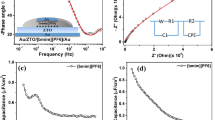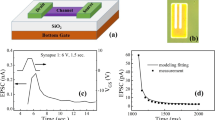Abstract
Temperature is one of the vital influential factors for all physiological and mental activities. Studying the influence of temperature on the properties of synaptic devices is of great importance for neuromorphic computing and bionic perception. Here, indium-gallium-zinc-oxide (IGZO) based electrical-double-layer neuromorphic transistors were proposed for the emulation of temperature-dependent synaptic functions. The influence of temperature on the synaptic plasticity, including excitatory postsynaptic current, paired-pulse facilitation, and dynamic filtering was investigated. Interestingly, temperature induced spiking AND to OR logic switching was demonstrated in an IGZO-based neuromorphic transistor with two in-plane gate electrodes. Our results provided an insight into the temperature-induced synaptic functions and spiking logic switching, which is interesting for neuromorphic systems with biological fidelity.
Similar content being viewed by others
References
Asztely F, Erdemli G, Kullmann D M. Extrasynaptic glutamate spillover in the hippocampus: dependence on temperature and the role of active glutamate uptake. Neuron, 1997, 18: 281–293
Li X, Zhou W, Yao S, et al. Effects of temperature on the activity of cultured hippocampal neuronal networks. Acta Biophys Sin, 2004, 20: 477–482
Karlsson K, Blumberg M S. Temperature-induced reciprocal activation of hippocampal field activity. J Neurophysiol, 2004, 91: 583–588
Micheva K D, Smith S J. Strong effects of subphysiological temperature on the function and plasticity of mammalian presynaptic terminals. J Neurosci, 2005, 25: 7481–7488
Zucker R S, Regehr W G. Short-term synaptic plasticity. Annu Rev Physiol, 2002, 64: 355–405
Ho V M, Lee J A, Martin K C. The cell biology of synaptic plasticity. Science, 2011, 334: 623–628
Voglis G, Tavernarakis N. The role of synaptic ion channels in synaptic plasticity. EMBO Rep, 2006, 7: 1104–1110
Thompson S, Masukawa L, Prince D. Temperature dependence of intrinsic membrane properties and synaptic potentials in hippocampal CA1 neurons in vitro. J Neurosci, 1985, 5: 817–824
Weight F F, Erulkar S D. Synaptic transmission and effects of temperature at the squid giant synapse. Nature, 1976, 261: 720–722
Postlethwaite M, Hennig M H, Steinert J R, et al. Acceleration of AMPA receptor kinetics underlies temperature-dependent changes in synaptic strength at the rat calyx of Held. J Physiol, 2007, 579: 69–84
Mahanty A, Purohit G K, Banerjee S, et al. Proteomic changes in the liver of Channa striatus in response to high temperature stress. Electrophoresis, 2016, 37: 1704–1717
Duan Q, Jing Z, Zou X, et al. Spiking neurons with spatiotemporal dynamics and gain modulation for monolithically integrated memristive neural networks. Nat Commun, 2020, 11: 3399
Yang J Q, Wang R P, Ren Y, et al. Neuromorphic engineering: from biological to spike-based hardware nervous systems. Adv Mater, 2020, 32: 2003610
Chen L, Wang L, Peng Y, et al. A van der Waals synaptic transistor based on ferroelectric Hf0.5Zr0.5O2 and 2D tungsten disulfide. Adv Electron Mater, 2020, 6: 2000057
Wan C J, Chen G, Fu Y M, et al. An artificial sensory neuron with tactile perceptual learning. Adv Mater, 2018, 30: 1801291
Li X, Tang J, Zhang Q, et al. Power-efficient neural network with artificial dendrites. Nat Nanotechnol, 2020, 15: 776–782
Wan X, Yang Y, Feng P, et al. Short-term plasticity and synaptic filtering emulated in electrolyte-gated IGZO transistors. IEEE Electron Device Lett, 2016, 37: 299–302
Wan C J, Zhu L Q, Liu Y H, et al. Proton-conducting graphene oxide-coupled neuron transistors for brain-inspired cognitive systems. Adv Mater, 2016, 28: 3557–3563
Liu Y H, Zhu L Q, Feng P, et al. Freestanding artificial synapses based on laterally proton-coupled transistors on chitosan membranes. Adv Mater, 2015, 27: 5599–5604
Zhu L Q, Wan C J, Guo L Q, et al. Artificial synapse network on inorganic proton conductor for neuromorphic systems. Nat Commun, 2014, 5: 3158
Li E L, Lin W K, Yan Y J, et al. Synaptic transistor capable of accelerated learning induced by temperature-facilitated modulation of synaptic plasticity. ACS Appl Mater Interfaces, 2019, 11: 46008–46016
Xiao M, Yeow T, Nguyen V H, et al. Ultrathin TiOx interface-mediated ZnO-nanowire memristive devices emulating synaptic behaviors. Adv Electron Mater, 2019, 5: 1900142
Grahame D C. The electrical double layer and the theory of electrocapillarity. Chem Rev, 1947, 41: 441–501
You I, Mackanic D G, Matsuhisa N, et al. Artificial multimodal receptors based on ion relaxation dynamics. Science, 2020, 370: 961–965
Shim Y, Kim H J. Dielectric relaxation and solvation dynamics in a room-temperature ionic liquid: temperature dependence. J Phys Chem B, 2013, 117: 11743–11752
Zhang J, Dai J, Zhu L, et al. Laterally coupled IZO-based transistors on free-standing proton conducting chitosan membranes. IEEE Electron Device Lett, 2014, 35: 838–840
He Y, Nie S, Liu R, et al. Spatiotemporal information processing emulated by multiterminal neuro-transistor networks. Adv Mater, 2019, 31: 1900903
Kuzum D, Jeyasingh R G D, Lee B, et al. Nanoelectronic programmable synapses based on phase change materials for brain-inspired computing. Nano Lett, 2012, 12: 2179–2186
Bi G, Poo M. Synaptic modifications in cultured hippocampal neurons: dependence on spike timing, synaptic strength, and postsynaptic cell type. J Neurosci, 1998, 18: 10464–10472
Chang G W, Chang T C, Jhu J C, et al. Temperature-dependent instability of bias stress in InGaZnO thin-film transistors. IEEE Trans Electron Dev, 2014, 61: 2119–2124
Dai C, Chen P, Qi S, et al. Ultrathin flexible InGaZnO transistor for implementing multiple functions with a very small circuit footprint. Nano Res, 2021, 14: 232–238
Zhao D, Fabiano S, Berggren M, et al. Ionic thermoelectric gating organic transistors. Nat Commun, 2017, 8: 14214
Bi G, Poo M. Distributed synaptic modification in neural networks induced by patterned stimulation. Nature, 1999, 401: 792–796
Gardner D, Stevens C F. Rate-limiting step of inhibitory post-synaptic current decay in Aplysia buccal ganglia. J Physiol, 1980, 304: 145–164
Karim M R, Hatakeyama K, Matsui T, et al. Graphene oxide nanosheet with high proton conductivity. J Am Chem Soc, 2013, 135: 8097–8100
Sun L, Zhang Y, Hwang G, et al. Synaptic computation enabled by joule heating of single-layered semiconductors for sound localization. Nano Lett, 2018, 18: 3229–3234
Regehr W G. Short-term presynaptic plasticity. Cold Spring Harbor Perspect Biol, 2012, 4: a005702
Fortune E S, Rose G J. Short-term synaptic plasticity contributes to the temporal filtering of electrosensory information. J Neurosci, 2000, 20: 7122–7130
Abbott L F, Regehr W G. Synaptic computation. Nature, 2004, 431: 796–803
Krueppel R, Remy S, Beck H. Dendritic integration in hippocampal dentate granule cells. Neuron, 2011, 71: 512–528
Jiang J, Guo J, Wan X, et al. 2D MoS2 neuromorphic devices for brain-like computational systems. Small, 2017, 13: 1700933
Acknowledgements
This work was supported by National Key R&D Program of China (Grant No. 2019YFB2205400).
Author information
Authors and Affiliations
Corresponding authors
Rights and permissions
About this article
Cite this article
Zhu, Y., He, Y., Chen, C. et al. IGZO-based neuromorphic transistors with temperature-dependent synaptic plasticity and spiking logics. Sci. China Inf. Sci. 65, 162401 (2022). https://doi.org/10.1007/s11432-021-3326-6
Received:
Revised:
Accepted:
Published:
DOI: https://doi.org/10.1007/s11432-021-3326-6




